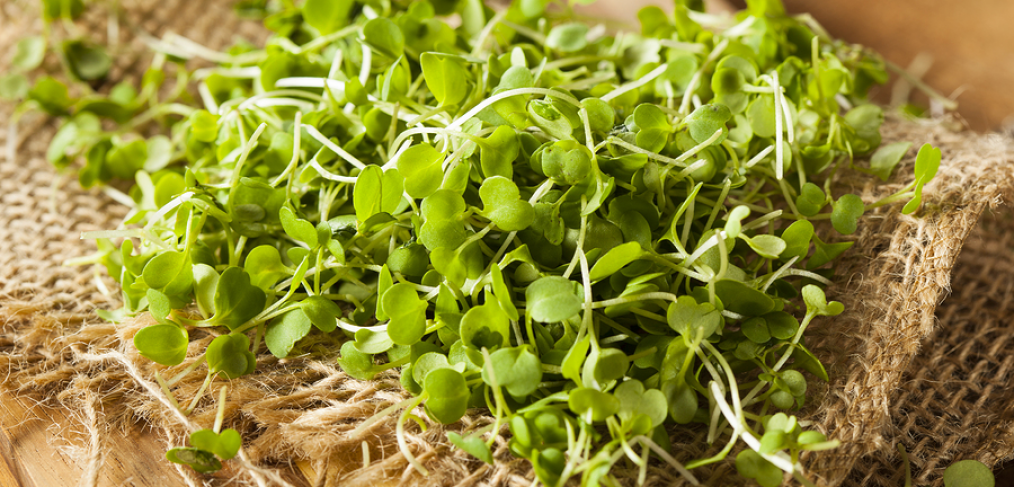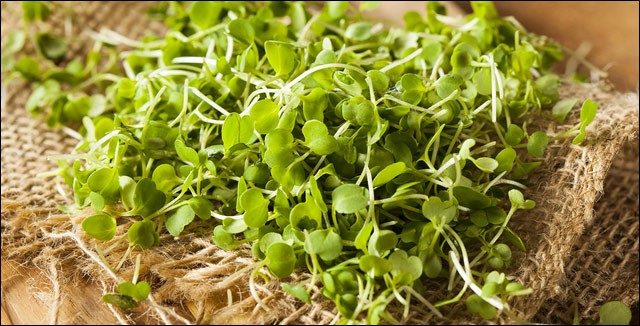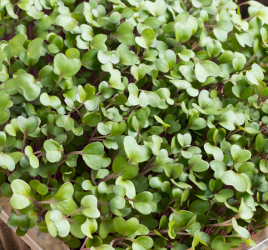
Supercharge Your Health with the Amazing Properties of Microgreens

Have you ever heard of microgreens?
If you are from California, these delicious tiny greens have been a staple on sandwiches and in salads for three decades. Microgreens are making their way across the country into supermarkets and restaurants and in amateur gardeners’ homes.
It’s so easy to grow them that some people are making a side business out of microgreen farming.
What Are Microgreens?
First, let’s talk a bit about what microgreens are and how they can make a significant impact on your health.
Microgreens are also known as micro herbs or aromatic greens. They can most often be found in upscale restaurants as they tend to pack a flavor punch.
However, they are simply very young vegetables that have only grown 1 – 3 inches tall. Many plants and even grains can be eaten at this stage.
You might be most familiar with wheatgrass juice or wheatgrass juice powder. It is a popular fresh addition you might find in a smoothie shop.
Microgreens are not sprouts, but they are not baby greens. They are somewhere in between.
Sprouts don’t have leaves, and they have a much shorter growing cycle. In addition, they are more prone to carry food-borne bacteria that cause illness than microgreens.
Microgreens are harvested after the first true leaves emerge, 7-21 days after germination.
Sprouts are harvested much sooner: 2-7 days after germination. Like baby greens, we eat the stems and leaves of microgreens, not the seeds and roots, as in the case of sprouts.
Microgreens can be sold before being harvested, unlike baby greens, which means when you eat microgreens, they have just been collected and are at the peak of freshness.
Health Benefits of Microgreens
The other thing microgreens give you is a concentration of nutrients.
In some cases, but not all, microgreens are more nutritious than their full-grown counterparts. This means that you can get the benefits of a whole salad with a small number of microgreens added to your meal.
Let’s look at some of the benefits of eating microgreens:
The nutrient profiles differ between plants, but in general, microgreens are high in
- Iron
- Zinc
- Copper
- Potassium
- Magnesium
We hear a lot about antioxidants and how they can help fight or reduce your risk of cancer. Raw vegetables and other foods are the best sources of antioxidants, and microgreens have them in abundance – a higher concentration than the same amount of mature plants.
Because the nutrient content of microgreens is concentrated, they contain more vitamins and minerals.
Some research suggests than microgreens can have up to forty times the levels of nutrients as mature greens, and a wider variety of antioxidants and something called polyphenols than seasoned vegetables.
Antioxidants & Polyphenols
We hear about antioxidants and free radicals all the time. However, do people know what they’re talking about?
Not all antioxidants are equal! For instance, since antioxidants are promoted so often, you may think the more you get the better.
Although you can find antioxidant supplements at nutrition stores, these can lead to some serious problems. The truth is that your body needs both free radicals and antioxidants in balance.
And the good news is that microgreens contain antioxidants in their most bioavailable form (hint: food).
A free radical is just a molecule that has lost an electron and is therefore unstable. We think of free radicals as bad because if left unchecked, they would destroy our bodies cell by cell.
However, our bodies contain many free radicals. Our immune systems use them to kill bacteria.
What antioxidants do is to donate an electron to a free radical, thereby stabilizing it.
With the proper balance of these two molecular structures, our bodies can fight off infection and remain stable.
But poor health habits promote too many free radicals and not enough antioxidants.
Polyphenols are micronutrients our bodies need, and they are high in antioxidants. As you will see below, they have been shown to be critical to our body’s ability to fight off heart disease, cancer, and other diseases.
Microgreens’ Effect on Diseases
As you may know, eating vegetables lowers your risk for many diseases because of the vitamins, minerals, antioxidants, and other beneficial things they contain.
Polyphenols are a class of antioxidants that have been linked in studies to a lowered risk of heart disease. Animal studies have shown that microgreens could reduce LDL cholesterol (bad cholesterol) and triglyceride levels.
Additionally, studies have also shown that polyphenols and other antioxidants may lower the risk for certain types of cancer.
Studies on diabetes show that certain types of stress can prevent sugar from properly entering your cells. Lab studies on fenugreek microgreens show enhanced cellular sugar uptake by up to 44%. Antioxidants help to reduce the stress leading to this problem.
Foods rich in antioxidants can also lower your risk for Alzheimer’s.
While none of these studies have been done yet on humans, it’s evident to anyone who has ever dieted before that an increase in vegetable consumption usually leads to better health.
What’s impressive about microgreens is their ability to give you a high dose of what’s good for you without the high volume needed by mature plants. These nutrients also come in a highly bioavailable form, which means that your body can easily absorb the nutrients in microgreens because they are food, and easily digestible. You can’t get that same benefit from a supplement off of a shelf.
Types of Microgreens & How to Eat Them
The following is a quick preview of the most common types of plants used for microgreens:
- Brassicaceae family: Cauliflower, broccoli, cabbage, watercress, radish, and arugula
- Amaryllidaceae family: Garlic, onion, leek
- Cucurbitaceae family: Melon, cucumber, and squash
- Apiaceae family: Dill, carrot, fennel, and celery
- Asteraceae family: Lettuce, endive, chicory, and radicchio
- Amaranthaceae family: Amaranth, quinoa swiss chard, beet, and spinach
- Rice
- Oats
- Wheat
- Corn
- Barley
- Legumes: chickpeas, beans, and lentils
As with any food you prepare at home, the risk of food-borne illness is a little higher.
Microgreens don’t require as much humidity to grow as sprouts, and so the risk of E. coli and Salmonella are much lower. Buying seeds and some supplies from reputable companies seems to reduce the risk of contamination and ensure the highest quality taste.
There are as many ways as there are foods to get microgreens into your diet.
Of course, the way to get the most nutrients out of them is by eating them raw.
- Put them in wraps or sandwiches, on salads, and in curries or soups.
- Cook them in a quiche or blend them in a smoothie.
- Use microgreens as a garnish on tacos or scrambled eggs.
Just try them! Soon, you will find your favorites and use them over and over again.
Bringing it Home
Microgreens are like super vegetables. You wouldn’t want to replace your diet with them entirely. However, with a little addition of these tender greens every day, you will find yourself getting healthier and healthier; not to mention adding new tastes and variety to your food!



